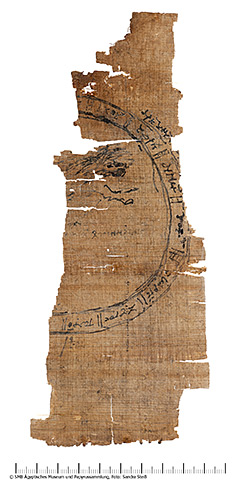P.Kramer 17 R (P. 13102 R)
Horoscopes. Up to our modern times, they are consulted by people in order to get an interpretation of their own fate or to get predictions about coming events. The timelessness of such questions for human kind is made clear by the millennia-old traditions of horoscopes. The zodiac with planetary position presented here formed the basis for creating a horoscope.
The papyrus originates from mummy cartonnage into which the papyrus was later processed. It was found in 1907 by Otto Rubensohn near Abusir el-Melek, on the west side of the Nile about 120 kilometers south of Cairo. The zodiac was written over an older account of wheat from Ptolemaic times, which can be dated to the 2nd–1st century BC. Two faded or removed lines of this account are still clearly visible in the middle of the circle. Below the circle, further traces of seven lines of rubbed-off ink can be seen. On the verso (the reverse side) of the papyrus there is an account, presumably for hay loads, which is probably somewhat younger than the account of wheat on the recto (the front). This was probably already there when the zodiac was created. The reuse of a papyrus already described for the creation of a horoscope as in this case is not special. It can also be observed in other horoscopes of the Berlin Papyrus Collection.
Since Hellenistic times, depictions of the zodiac have been popular motifs in ancient art. These were captured in mosaics, sculptures, celestial globes and flat reliefs. In spite of the widespread subject, hardly any representations of zodiacs on papyrus have survived to this day. In most cases these are circle drawings with written indications of the signs of the zodiac.
The Berlin Zodiac is dated in the period between the 1st century BC and the 1st century AD. On the preserved fragment the right side of a zodiac can be seen with the names of the zodiac signs in the margin and further notes outside the circle. In the centre of the circle is an animal running to the right, but its identification is unclear. For a representation of the Zodiac Helios with the Quadriga of the Sun, as it is often found within zodiacs, the front part of the animal already takes up too much space, which, moreover, resembles more a dog or a lion than a horse.
The series of signs of the zodiac begins at the top in the middle with the constellation of the beginning of spring, Aries, as is often the case in ancient zodiacs. Then the rest of the signs of the zodiac follow in order. The notes outside the upper right corner of the zodiac are the names of the planets Mars, Jupiter and Mercury. The positions of the planets are similar to those in other ancient representations of zodiacs, suggesting the purpose of the zodiac. It was probably used to record the constellation of the stars at a certain time in order to create a horoscope. Against this background, it can be assumed that other planets such as Venus and Saturn as well as the Sun and Moon were also noted on this zodiac.
We will never know how the message of the horoscope to the person who had it created was, whether it was useful or even revealed answers to essemtial questions of human kind. For although the usefulness of horoscopes was astrological in nature, their form was purely astronomical – the astrological interpretation, the horoscope, was not written down.



